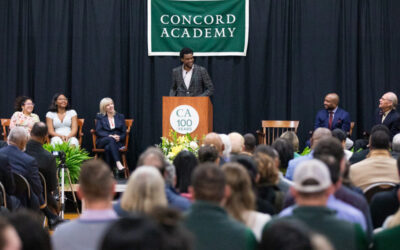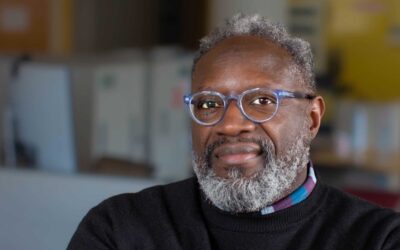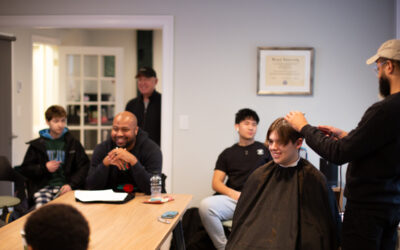Chapel Talk
Rick Hardy
September 6, 2017
“Sprout” (Chen Yi and Third Angle New Music Ensemble)
Good morning, everybody. This is the second of many mornings that we will gather here in this Chapel, and I am grateful for the opportunity to speak to you today. As all of you know, this past summer was challenging, both here in the US and abroad:
- We saw disturbing violence spurred by white supremacists in Charlottesville, hate groups whose actions were then excused by our president;
- We have seen the escalation of rhetoric and tensions between the leadership of North Korea and the United States, raising concerns throughout eastern Asia;
- We saw devastation and flooding in Southeast Asia and here in the Houston area – and now, with Hurricane Irma increasing to a category 5, Florida is bracing for yet another storm.
These events touch us, because, regardless of where we live in the world or what political views we hold, we are part of the human community.
Like you, I feel a range of emotions about these events. Concern for the well-being of my fellow Americans, especially people of color. Fear about the impact of careless rhetoric and instability on those I love, and on the communities that I care about. Gratitude for those who put themselves in harm’s way to respond to emergencies. And a profound appreciation for people who risk their own safety to ensure that we all get to stand and be counted, to speak and be heard, to be dreamers, all of us.
As the head of this school, I want to offer all of you a simple assurance:
That you are welcome here.
That you are safe here.
That you are valued here.
That your voices will be heard and respected here.
These values are written into our mission, which reads:
Concord Academy engages its students in a community
animated by a love of learning,
enriched by a diversity of backgrounds and perspectives,
and guided by a covenant of common trust.
These values are CA’s North Star, which will guide us and to which we will return again and again. Each of you will help to bring this mission and these values to life. By speaking them, by learning them, and by living them.
Perhaps no place on campus is more emblematic of CA’s mission and community than this chapel. Many of you know its story, that it was formerly a Baptist church in Barnstead, NH; that it was brought here by then headmistress Betty Hall and a crew of six, including her husband Livy, her colleagues Doreen Young and Bill Eddy, along with Bill’s wife Beryl and his friend Conrad White, and one student, Belinda Burley, who together made real “the dream of a Chapel standing at the end of the Academy garden.”
Various enhancements have been made since 1957, yet through these changes, the chapel has remained what it has always been: the spiritual heart of the community.
A neat and simple story. A tale of hard work and success, the finished structure an emblem of achievement. But that is not the whole story. This building began as a problem; as Mrs. Hall put it, “There was no space for quiet in a crowded school.” Over a period of years, she and her colleagues had hopes, followed quickly by doubt, fear, and, in the physical process and financial investment, risk – significant risk. There was no straight, unbroken line between seeing a problem and crafting a solution. Life is not like that. Each of those elements – doubt, fear, and risk – were essential parts of the story.
These are emotions that I experienced this summer, a few thousand miles from here.
My story begins with a photograph taken this past June at the North Rim of the Grand Canyon. In the photo, two friends and I are sitting outside at dusk on a low wall at the North Kaibab Trailhead; we are smiling. We have just completed a hike that began before dawn on the South Rim of the canyon. We look tired, but happy.
And that’s not the whole story.
My friends Kevin, David, and I had been planning this hike for a year. Kevin had done the rim-to-rim four previous times, but David and I were first timers. We bought plane tickets, reserved hotel rooms, and we trained, hiking as many miles and up and down as many hills as we could find. We were ready, or as ready as we could be. Kevin sent us an email a couple of days before we were to depart. He wrote:
“two things. first, I only worry about heat. drink early and often. don’t wait till you’re thirsty. if we perceive a risk, we take a break. opportunities exist to submerge yourself in various tributaries. I’d rather be three hours ‘late’ and safe.
second, my sons tease me because I plan. however, I believe in improv.”
We landed in Phoenix on June 22, in the middle of a heat wave and a string of wild fires in northern Arizona. We drove to Flagstaff that same day, and then to the South Rim of the canyon the next morning. Three of us – my wife Adele, David, and I – had never visited the Grand Canyon before. Kevin parked the car near an overlook to give us our first glimpse. As we stepped out of the car, the three of us uttered a predictable “Oh…my…god,” and just stood there. You can read descriptions of the canyon and even see photographs, but I’m not sure anything will prepare you for just how beautiful and vast it is.
Kevin broke our reverie by pointing across the canyon to the North Rim, which seemed absurdly far away.
“That’s where we’ll be tomorrow night,” he said.
With luck, I thought. Temperatures in the canyon would be well over 100 F during our hike. Not ideal, to say the least.
As we talked later that evening, we agreed on a few ground rules:
- we would take the time to see, really see, the canyon;
- we would keep an eye on each other;
- we would keep moving, if sometimes slowly, but we would take rest breaks as often as we needed to;
- we would let each other know how we were feeling – honestly, particularly if any of us was struggling;
- and if one of us did have significant trouble, we would all spend the night in the canyon, and then hike out in the morning.
We set out at 4:30 the following morning. Although the sun had not yet risen, the trail was visible in the early dawn light. I wore a wide-brimmed hat, a sun-protectant shirt and pants, and a handkerchief wrapped around my neck. Each of us was carrying 3 liters of water, a little food, and a few other necessities. As we started down the South Kaibab Trail, Kevin reminded us not to run our hands along the rock shelf to steady ourselves as we hiked down; sometimes rattle snakes curled up there and would be… annoyed if we woke them.
An hour and a half into the hike, tall yucca plants dotted the landscape. The Colorado River was visible some two thousand feet below us, but where we stood was silent, complete and extraordinary. We moved deliberately – feeling the effort in our knees and quads – and made it to the river and the Iron Bridge by about 8:30. I felt a little sore, but good. I had consumed almost all three liters of my water and I did not feel thirsty. At Phantom Ranch, we refilled our water bottles, rested briefly, and moved on.
The hike across the canyon floor was approximately 7 miles in length, and as the sun rose higher, the temperature steadily climbed to 100 F. As the noon hour came closer, we found ourselves in full sun with no shade whatsoever. The trail was in parts a slog through sand. My leg muscles ached. The heat was brutal. I remember having a conversation with someone who had said, “Well, it’s hot in northern Arizona, but it’s a dry heat. You don’t sweat the way you do here in New England.”
I’m here to tell you: that’s not true – you sweat. You sweat. A lot.
On the way down into the canyon, we had stopped only a few times, always to take in a new sight or to take photos, not to catch our breath. For me, that changed as we made our way across the canyon floor. My breathing was more labored, and with virtually no shade to be had, I had to stop every few minutes to guzzle more water and rest. When we resumed hiking, my pace got slower and slower. I knew Kevin and David were worried about me. I was worried about me.
As we rested in the limited shade of a leaning rock, I told them I was struggling. I had run several marathons in hot weather – though nothing like this – and I recognized the signs of heat exhaustion. Although I had not eaten much in the last two hours, I had no appetite. I was thirsty but I was having trouble getting water down. I felt tired – really tired, and even though we stopped to rest frequently, I felt no relief. I knew I needed to cool down my core – and fast.
We detoured directly to the creek, which was low but running. As I took off my boots and socks and shucked my pack, I could see that the water was under a foot deep. It would do. I stepped into the creek and sat down; I wiggled my bottom to make room for my body, and then lay back, submerging myself and letting the water run over me. I covered my face with my hat and closed my eyes.
Within minutes I felt better. My mind seemed sharper. I was able to talk with my partners. I was hungry and ate a bar and some dried fruit, washing it all down with water that was now warm. It didn’t matter. I put my socks and boots back on, shouldered my pack, and rejoined my mates on the trail. I felt strong and good – for about an hour. Then I felt just as bad as I had before the first immersion.
Fortunately, we reached Cottonwood Campground by about 1:00 pm. Kevin led us down to the creek, and I was thrilled to see that, rather than the shallow depth we had found earlier, a deep and shaded pool awaited us. I learned from Kevin that CA students, on a trip with Kem Morehead and Kim Crawford-Harvie, had created this pool by piling up river rocks into a makeshift dam. I slid into the pool, uttering thanks to Kem, Kim, and those CA students. Perhaps some of them are here today. If so, let me thank you – no exaggeration, you saved me!
As we were leaving Cottonwood, we passed a thermometer reading 112 F (in the shade). A bit farther down the trail, we met a young woman huddled under a rock overhang. She told us her name was Anna and she was hiking alone; she thought she was doing all right, but now she was feeling nauseous and could not bring herself to drink the warm water in her canteen. I shared some of the dried ginger I was carrying – which is useful for countering nausea – and after she had that she was able to drink some of her water. She told us that she was a cardiac surgery nurse currently studying for a PhD. at UCLA. We insisted that she come with us, and she readily agreed. So now we were a group of four – including a cardiac nurse, just in case.
Just before we began our climb up to the North Rim, all four of us immersed ourselves in Bright Angel Creek one more time. We were in the shade now, and though the temperatures were still above 100 F, we felt refreshed and optimistic as we started our ascent. We rested often, and even though we were behind our original schedule by about an hour and a half, we knew that we were okay. We reached the Supai Tunnel, 2 miles from the North Rim, by 6:30. Perhaps 45 minutes later, we met my wife Adele, and a short while later Kevin’s wife Leila, who had hiked down to meet us. I’m not embarrassed to say that seeing my wife brought tears to my eyes, so grateful was I to see her. When we reached the North Kaibab Trailhead, we took that photo, and several others. I looked back down the trail as darkness fell, replaying the day that we had just lived, the steps we had taken.
Over dinner that evening, I was reminded of something the poet Robert Pinsky said some years ago at his commencement address here at CA, when he noted that achievements, whether it was a letter of admission to college or first prize in a competition, were not in themselves important; what was important was that we dedicate ourselves to grappling with something really hard, a “worthy difficulty” he called it. Dedicate ourselves without knowing the outcome, without measuring our success, and without desire of recognition.
“Would you do the rim-to-rim again?” someone asked at dinner. As hard and as risky as it was, and despite our moments of doubt, each of us said yes. Perhaps not on a day when the temperature topped 100 F, but yes – yes.
Human beings are complex creatures; from the elaborate circuitry of our nervous systems to the layers of memory embedded in our brains, there is more to us than we will ever understand. And that, perhaps, is the point: if we can devote ourselves to trying to understand, to exploring our limits, to doing our best and perhaps falling short, to trying again, to meeting that difficulty again, we are being true to ourselves. What is love of learning but grappling with a worthy difficulty?
In June of 2005, former Head of School Jake Dresden gave a talk to alumnae/i as part of the year-long celebration of the completed chapel renovation. He noted that his audience likely remembered their own chapel talks, “maybe more than any event in [their] CA career. [But w] hy is this true?” he asked. “Why does that fifteen minutes hold such a power in the lives of our students? The answer comes,” he said, “from the combination of two seemingly contradictory forces: the beautiful simplicity of this space and the beautiful complexity of the words seniors speak here.”
He was right. As human beings, we labor to make ourselves understood to others; when we manage to communicate something real and true about ourselves, when we share our doubts, our fears, and our risks, and feel heard, we experience one of the most powerful and important emotions within us: acceptance. The story of this year, for every one of us, will involve moments of doubt, fear, and risk. In the aftermath of the events of this summer, in the world outside of our CA community, we must strive to live our mission and our values.
Look out for each other. Be honest about how you’re doing, how you’re feeling. Ask for help when you need it. It’s not a sign of weakness — but a sign of intelligence and strength. The journey will at times be difficult, but it will also be worth it. As Adam Bailey reminded us yesterday, the journey we are taking is best taken with others, with friends; and as Kaity told us, wherever you go, be who you are.
I will look out for you, too, and I will make this journey with you. That’s a promise.
Thank you for listening, everyone.
“Stand by Me” (Lyrics by Ben E. King, performed by Tracy Chapman)


